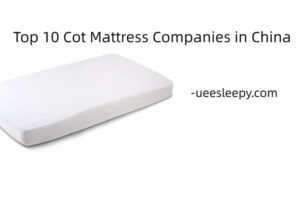If you have spent even ten minutes browsing the internet looking for a new pillow, you’ve probably noticed that there are many options. What is the best pillow for you? This guide compiles the top 10 pillow manufacturers in the market for your reference along with advice on how to pick the right pillow.
1. 10 Top-Rated Pillow Manufacturers
Here is our list of the top 10 pillow manufacturers in the market.
1) Coop Home Goods
The Good Housekeeping Institute named Coop Home Goods memory foam the best custom pillow for any sleeping position. This pillow comes with extra fill, so you can add or subtract fill to your liking.
2) Wamsutta
This top performer in the Good Housekeeping Institute’s lab tests is also affordable, at under $20. It springs back to its original shape when the weight is removed, is comfortable and supportive, and is easy to clean.

3) Ueesleepy
Ueesleepy’s TPE bedding holds more than 58 patents and produces up to 20 million pillows and mattresses annually. Their products include TPE pillows, TPE cushions, TPE mattresses, obtained SGS, REACH, and ROHS… And other standards. TPE pillows and TPE sheets are their most advantageous products.
4) Pacific Coast
The brand’s Double DownAround Soft Pillow features a double-down design with a soft outer down and a supportive feather inner pillow. Testers from the Good Housekeeping Institute appreciated its quality construction.
5) CleanRest
CleanRest’s hypoallergenic model provides comprehensive protection against toxins, bed bugs, and dust mites. This pillow is suitable for both back and side sleepers, and it avoids the “crunching” sound that other hypoallergenic pillows made of polyester make.
6) I Love My Pillow
The makers of I Love My Pillow’s main products are Memory Down, Contoured, and Traditional Memory Gel, all covering a range of sleep preferences. Reviewers found traditional memory gel products to be the most stable.
7) Bear Pillow
The Bear Pillow is made of a solid polyfoam core called LOFT-X Hybrid Foam that molds to your neck, spine, and head. This special material is more supportive than memory foam and has the bouncy and responsive qualities of high-end latex.
8) Xtreme Comforts
The bamboo pillow from Xtreme Comforts is adjustable and hypoallergenic. Designed for sleepers, bamboo is breathable and lightweight, keeping you cool and comfortable while you sleep. In addition, it pays great attention to the quality of pillows. In order to ensure that the pillows will not be damaged during transportation. They use customized high-quality boxes made by a corrugated box machine to transport the pillows.
9) Zen Bamboo Ultra
The Zen Bamboo Ultra Plush Gel Pillow features gel-filled fibers for all sleeping positions. Hypoallergenic bamboo makes it a little more expensive than traditional materials.
10) My pillow
Reviews on My Pillow have given this product a bad rap for its hefty price tag and low quality. My pillow complaints include polyurethane-like interlocking filling and cheap, uncomfortable material.

2. How do I pick the perfect pillow?
OK, let’s start with the first square. At the end of the day, your pillow’s most important job is to keep you in your best sleeping position throughout the night. And when I say “support,” I don’t just mean feeling soft and comfortable. A well-fitting pillow should keep your head, neck, and spine in neutral alignment and support the natural curvature of your spine. Maintaining a neutral spine not only relieves neck pain but also reduces stress throughout the body.
Pro tip: When you are unsure whether your spine is in neutral alignment, make sure your ears are aligned with your shoulders and your chin is aligned with your sternum.
Now, here’s the tricky part: Every sleeping position requires a different type of pillow for healthy posture. I’ll tell you exactly what to look for in each style of bed, but don’t forget to shop for pillows too! Once you’ve met your body’s needs and found a pillow that supports a neutral spine, you can drill down to all the little details that will meet your needs. There are hundreds of pillows out there, so you might as well find the right one for you.
The position in which you sleep is only a reflection of your sleeping habits, and there are many more factors to consider when you’re buying a pillow. For example, thermal pillows, memory foam lovers, environmentalists, and latex lovers may all require a specific type of pillow to suit their personal preferences. You should always choose a pillow that supports a healthy posture, but it should also be compatible with your entire body.
That said, I’m going to mix and match some of these “wants” with different sleep styles. Then you can decide what special features you want in your pillow based on how you maintain spine neutrality in each sleeping position!
3. Choosing the right pillow for sit-ups
To maintain a healthy posture, supine sleepers need what I call a “happy medium pillow,” which means it has a medium loft and medium firmness. Additionally, back sleepers may find pillows filled with pressure-adapting materials, such as memory foam, especially beneficial. To see the wide range of options available, check out our list of the best pillows for back sleepers.
“But why would a back sleeper need a medium-loft and firm pillow?” you’re probably asking. Well, I’m glad you asked. Let’s take a closer look:
- Medium Loft — Medium loft will help relieve neck and shoulder pressure by providing a comfortable and comfortable cushion between you and the mattress. If your pillow is too high, your head will stretch upwards. If it’s not high enough, you can pretty much lie flat on the mattress.
- Medium firmness — Medium firmness will give your head enough support to align with your spine and ensure the pillow doesn’t flatten out at night. If your pillow is too soft, it’s likely to deform under the weight of your head.
- Compliant Compression – Material designed for tight conforming compression keeps the head comfortable and in neutral alignment with the neck. In addition, a pillow with a tufted top will provide some extra cushion for your temples (many back sleepers tilt their heads one way or another).
Now that we know more about the ideal construction of a backrest pillow, let’s take a look at some special features that might make your dream journey easier. Remember: These features aren’t mandatory (nor are they exclusive to back sleepers), but the more you learn about the world of sleep accessories, the better you’ll be able to find the perfect fit.
- Customizable support – The bedding industry is increasingly designing pillows that sleepers can customize. Additionally, many pillows offer adjustable fill, meaning you can unzip the outer fabric and adjust the inner fill until you find the feel and support that best suits your body. This is especially useful for mixed sleepers or those who are still figuring out what the perfect sleep pattern is.
- Cooling Properties – People who prefer to sleep hot should look for pillows with cooling properties. Pillows with cooling yarns or phase-change materials woven into the fabric are ideal for sleepers who want to feel cool throughout the night. The phase change material, in particular, is designed to make your pillow feel like it’s been refrigerated – very cool to the touch.
- Resilient Support — Another thing to consider is what kind of support you want your pillow to provide. Some people don’t like to sink slowly into the pillow and may feel trapped by the form-fitting foam.
I bet you’re thinking, “Wow, I didn’t know my pillow could do all that!” Well, keep reading, because side sleepers are next.
4. Choosing the right pillow for side sleepers
Side sleepers need a pillow with a high loft and firmer support to maintain a neutral spine. Side sleepers may also find fluffy materials like kapok or moldable materials like down to be especially helpful for side sleepers. The reasons are as follows:
- High Loft — The most important benefit of a taller pillow is that it supports your head in neutral alignment with your spine. Additionally, a tall pillow takes the pressure off your shoulders and ensures it doesn’t take the brunt of your body’s weight. If you feel like your shoulders are sinking deeply into your mattress, your pillow may not be high enough.
- Firm support — A pillow with a medium-firm or firm support level will keep your head and neck in line with your spine throughout the night. If your pillow is too soft, your head will gradually sink over the course of your 40 blinks, throwing your spine out of neutral (hello, a stiff neck).
- Fluffy and buildable — Firmer pillows can take some getting used to, so I recommend looking for a fluffy material like kapok, down, or a down alternative. The materials themselves are very soft, so make sure your pillow has plenty of padding and a high loft. However, finding a pillow that can be fluffed up in a taller loft is often beneficial for side sleepers with wider shoulders. Plus, the easy-to-shape pillow allows you to slip one arm under the pillow for a snug hug, which is a great option for many side sleepers.
Now, if you want to check out a variety of pillow options, check out my roundup of the best pillows for side sleepers. In the meantime, let’s dive into some more specific sleep accessory needs.
- Moisture Wicking – Just because a pillow is designed to cool down doesn’t necessarily mean it’s also designed to wick away moisture. So if you’re going through menopause or prone to night sweats, it’s best to choose fabrics that are naturally absorbent. Polyester, Tencel, and bamboo are all good examples of materials that aren’t designed to be cool to the touch…but wick away moisture while you sleep.
- Natural and Organic — If you have sensitive or acne-prone skin, sticking with pillows made from all-natural materials may be right for you. Organic cotton, cellulose fibers, and natural latex are all good options for sleepers looking for organic, hypoallergenic materials. Remember: you don’t have to choose between top fabric and interior filling. There are many bedding brands that exclusively use natural materials for their sleep accessories.
- Breathable foam —there’s a reason memory foam is so popular—many sleepers can’t get enough of the deep foam and slow response to pressure. However, sleepers don’t always like memory foam because it tends to trap body heat. How can we solve this problem? Aim for pillows filled with shredded memory foam rather than a solid block of foam. Individual popcorn-sized pieces are able to move freely within the pillowcase, allowing for better breathability. This way, the pillow can dissipate your body heat while you still get that classic memory foam feel.
Now we know what back and side sleepers should look for in their pillows, but did you know that many sleepers switch back and forth between the two positions? If you like a back/side sleeper combination, be sure to check out my roundup of the best pillows for combination sleepers. But here’s a tip: Combination sleepers should choose pillows with adjustable padding. This way, you can personalize your pillow to suit your most frequent sleeping position.
5. Choose the right pillow for your stomach sleeper
When it comes to sleeping on your stomach, finding the perfect pillow can be a little tricky. In fact, some experts recommend avoiding the prone position altogether because it tends to place the upper cervical spine in terminal rotation or extension. Essentially, this means you run a greater risk of straining your neck and putting pressure on your lower back or abdomen.
That said, I consulted with Dr. Keith Poorbaugh, a physical therapist at the Sleepopolis Expert Network, who told me, “To reduce the risk of sleeping on your stomach due to joint pain in your shoulders or spine, your best bet is to use an appropriate pillow.” In what circumstances should a prone person use a pillow support? Well, let’s check it out:
- Low loft – To maintain neutral spine alignment, prone sleepers need low loft (two inches or less) pillows. If your pillow is even slightly high in the loft, your head will be thrown upwards and the whole posture will be messed up. Remember: You should use a pillow that supports your spine’s natural C-curve.
- Soft Support — A pillow with soft support will provide comfortable cushioning between you and the mattress while making sure your head isn’t propped up too high. The harder the pillow, the more likely it is that your neck will be elevated and out of alignment with your spine (which is when soreness starts).
- Compressible Fill – Pillows filled with a feather or down alternatives are ideal for prone sleepers. Why? Well, these materials are easily compressed into ultra-low lofts. They’re also very easy to shape, which is great for tummy sleepers who prefer to hug the underside of the pillow instead of resting their arms at their sides. Additionally, finding a pillow with adjustable fill is a bonus, since you can reduce the loft as necessary.
Let’s explore some other features you might wish your pillow had.
- Pillowcase First – To support certain postures or body types, pillows often come in obtuse shapes or deep contours. Unfortunately, this isn’t ideal for people who want to decorate their pillows with pillowcases. If you have some silky, decorative pillowcases you’ve been dying to use, aim for pillows that advertise “traditional” shapes. Conversely, if you don’t want to bother with pillowcases, opt for fabrics known to be smooth and hypoallergenic (like Tencel or organic cotton).
- No Animal Products – As I said, down is great for belly sleepers because it molds and compresses easily to a very low loft. However, not everyone wants to sleep on animal products. Then what should be done? In the process of making down alternatives, such as poly gel or micro denier, no animals were harmed. It’s also a benefit for those who prioritize ease of washing
- A Socially Conscious Brand — Want your pillow to be more than just a good night’s sleep? See bedding brands participating in social impact programs. Do a little research and you’ll find that many bedding brands are involved with charities.

6. Common questions
Here are some frequently asked questions about pillows.
1) How can I be sure I am using the correct pillow?
When choosing a pillow, keep the following in mind: The right pillow should neutralize the head, neck, and spine and support the natural curvature of the spine.
2) If you like to sleep on your back, what type of pillow is best to use?
Back sleepers should look for a “medium” pillow, which means it has a medium loft and medium firmness. Pillows made of pressure-compliant materials, such as memory foam, are best.
3) Which pillow is best for side sleepers?
Side sleepers need pillows with high loft and firmer support. Pillows made of materials that can be fluffed like down are also recommended.
4) Which pillow is best for sleeping on your stomach?
Some experts recommend avoiding the prone position altogether, as it tends to place the upper cervical spine in terminal rotation or extension. However, for prone sleepers who cannot otherwise sleep, pillows with low loft, soft support, and compressible filling such as feather or down are recommended.
How useful was this post?
Click on a star to rate it!
Average rating 5 / 5. Vote count: 4
No votes so far! Be the first to rate this post.






